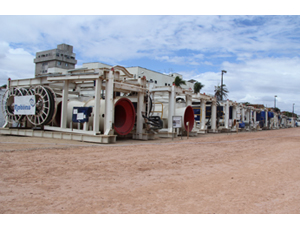

As demonstrated by this summer's fare-increase riots—which caused an estimated 1 million protesters in São Paolo and other Brazilian cities to take to the streets—public transportation is a crucial issue for the burgeoning country. Next year's World Cup and the 2016 Olympic Games will add tremendous strain on the country's infrastructure. Brazil's federal government is not sitting idly, however: Its largest-ever public transit project launched in November.
Located in northeast Brazil, Fortaleza is the fifth-largest city in the nation, home to 3.6 million residents, and a major tourist destination thanks to its beaches. The new East Line of the Fortaleza metro is the largest public works project in the history of the state of Ceará, according to Marco Escóssia, the spokesman at Ceará's infrastructure ministry SEINFRA. It is expected to carry 400,000 straphangers daily when it opens in 2019.
A consortium of the Spanish firm Acciona and Brazilian engineering firm Centenco Engenharia won a tender and in October signed a contract for the East Line. The $973-million bid was the lowest, but still the largest urban transit contract ever signed in Brazil, according to Escóssia. Brazilian President Dilma Rousseff visited the site in November. Construction includes two 7.8-mile tunnels, each 28 ft in diameter, 11 new stations, an expansion of a station linked to two existing lines and work on bus terminals. In the middle of the alignment, due to constraints of the street above, the tunnels and stations will be stacked one atop the other, according to Jose Maria Diaz Alvarez, an engineer and commercial director of Acciona Infrastructure in Brazil.
The new line is part of a $1.3-billion public-private partnership evenly split between the federal government, the government of the state of Ceará, and the Caixa Econômica Federal, Brazil's government-owned bank. Funds from the program will cover the construction of the line, property expropriation, operational costs of the four metro lines, and project management.
The main challenge, Escóssia points out, is performing the work along a major urban corridor, Avenida Santos Dumont, without negatively affecting the city's population. To speed up the process, the project will use four earth-pressure-balance (EPB) tunnel boring machines, nicknamed “tatuzões” (giant armadillos). Two will start at the north end of the line in the city center, where the new East Line will connect with two other metro lines. Two more TBMs will be dropped in the middle of the new line, where it will connect with the fourth, above-ground metro line, as well as the bus terminal.
Dropping the TBMs in heavily-trafficked sites that are already constricted presents additional challenges, as does tunneling the new East Line alongside a section of the existing and active West Line. In addition, boring the shaft for the later two TBMs, constructed in the middle of the future line, will have to occur without interfering with the structure and function of the south line.
"We are aware that previous studies and geotechnical calculations, preventative and control measures during the execution phase, as well as studies of ground conditions during construction, are all critical to the success of the project—and, above all, to avoid to the fullest extent possible inconveniencing the residents," Alvarez says.
Two of the TBMs arrived in November from Shanghai, where they underwent testing by the firm that will perform the assembly, the U.S.-based Robbins Co. The 410-ft-long TBMs weigh 812 tons each and were shipped in 16 containers in 50 pieces. A unit of Robbins is performing testing on the remaining two machines still in China.
The excavated material will be pulled out via conveyor, and two onsite factories will produce 20 concrete rings a day for the tunnel supports. Four independent systems will perform ventilation during excavation.
By the end of 2014, the team expects to integrate the South and East lines and complete 2 miles of the tunnel boring.







Post a comment to this article
Report Abusive Comment